Disclaimer: Making whisky at home is illegal in all 50 USA states. This post just goes over the process on how to make your own whisky but we are not encouraging you to do so. Please check the distilling laws in your state before doing anything.
Whiskey, just like bourbon, brandy, rum, vodka, and gin is an alcoholic beverage in which the alcohol content has been increased by distillation.
Many think whisky and bourbon may be the same thing but there is a slight different. See our How to Make Bourbon guide here.
What Ingredients are Used to Make Whiskey
Whiskey is made from just three ingredient:
- water
- barley (or other types of grain depending on the kind of whiskey being made)
- and yeast
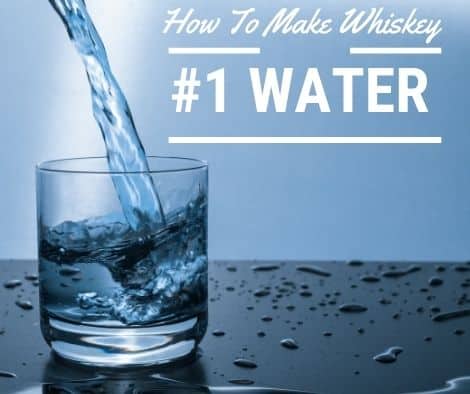
Water:
Water is a multifaceted ingredient that plays three major roles in the production of whiskey, starting from the mash process, distillation process to the cask maturation process.
The quality of water plays a pivotal role towards the quality of the finished product. Contaminated water can affect every stage of the whiskey making process, and alter the taste, odor, and color of the whiskey.
Water used in the whiskey making process should be clean, clear, and free from bad-tasting impurities such as iron. Bad water can ruin all the efforts put into the distillation process after maturation, resulting in an abrupt, hot finish.
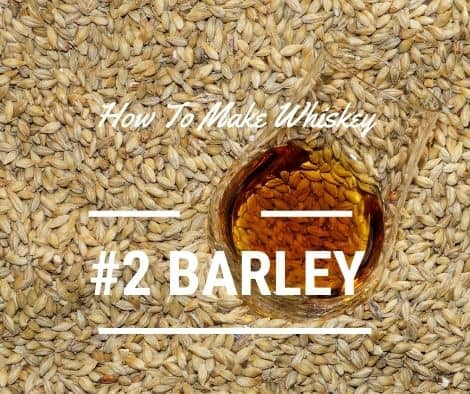
Pick Your Grain:
Most whiskeys are made from a blend of several different grains such as barley, corn, rye, and/or wheat grain. Grains are responsible for creating texture, and depth, and for bringing out the best potential flavor of each grain used in the mix.
Barley for example packs a mean punch, and is mostly used in Scotch whisky. Scotch barley whisky possesses an inherent bite, and typically has a smoky, earthy character. Corn whiskey features creamy flavors, and notes of toasted marshmallow.
Wheat was once less mainstream, but today is a hit in the whiskey world. Almost all wheated whiskeys are made in the USA, and are billed as one of the smoothest whiskeys made.
Rye is an extremely versatile grain, and features the same dried and ripe fruit flavors as corn-based whiskies, but with an extra dose of nuttiness and spiciness.
Yeast:
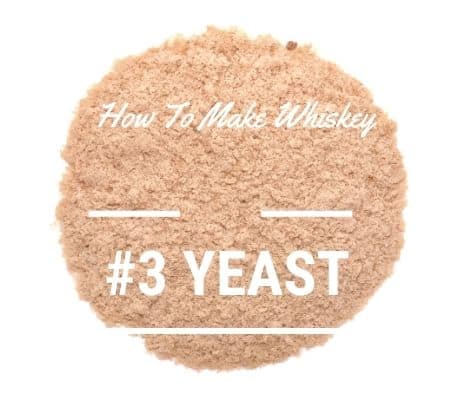
Using the proper yeast will start the fermentation process to remove the sugars to convert the mash into alcohol.
The Whiskey Making Process Explained – Manufacturer Level
Preparing the Grain aka Malting
Grain shipped to the whiskey manufacturer is first stored in silos, and then inspected and cleaned to remove all the dust, and any other foreign particles that may be present. Except for barley, all other grains are ground in a gristmill.
The resulting meal from the grind is then mixed with water, and then slowly cooked in a closed pressure cooker at temperatures up to 310°F The meal can be cooked even more slowly in an open cooker at 210°F.
Barley contrarily is not cooked, but is malted — a process that involves soaking it in water, and then spreading it out, and keeping it moist for roughly three weeks This process of malting basically helps the barley sprout or germinate, and converts it into sugars.
Mash and Wort
The malt once milled is mixed with hot water to extract the starch, sugars, and other compounds. This process continues until the starch is turned into fermentable sugars.
Ground malt barely is typically added even if the distiller isn’t making malt whiskey, as it helps accelerate the reaction of converting starch into sugars.
Mashing produces a porridge-like mixture aka wort — a product that contains important sugars such as maltose and maltotriose.
Fermentation
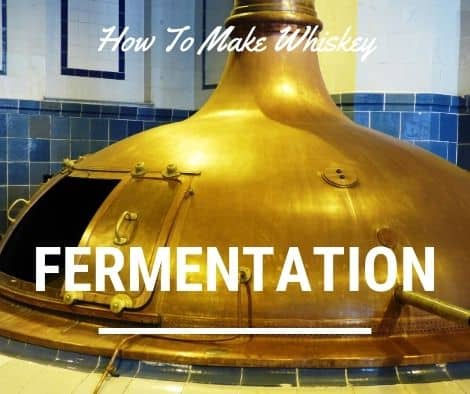
The mash is cooled and transferred to large vessels (fermentation vessels). These vessels are generally open in the United States and closed in Scotland, and can be made from wood or stainless steel.
Next, yeast is added to fire up the fermentation process, and to get rid of all the sugars in an effort to convert the wort into alcohol.
The fermentation process can take anywhere between 48 to 96 hours, but some distilleries may stretch the process to create different taste characteristics. The end result from fermentation contains roughly 5-10 alcohol ABV, and is referred to as distiller’s beer.
Distilling
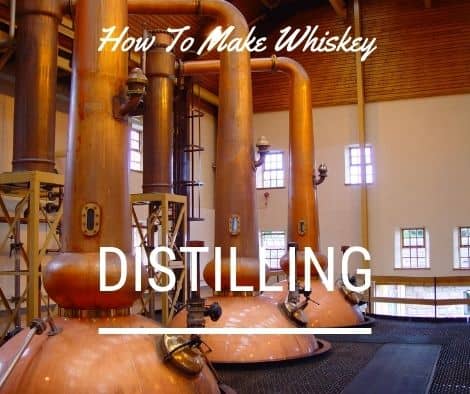
You can get complete distilling units here
Whiskey makers generally distill their wash in traditional copper stills. Most stills are made from copper, and for several good reasons, most notably because it is easy to mold, conducts heat efficiently, and is corrosion resistant.
Then there are two common types of stills — column stills and pot stills, each differing slightly in terms of functionality. Column stills are also referred to as Coffey stills or continuous stills are used mostly in modern distilleries.
Coffey stills feature a tall cylindrical column with perforated plates, and allow steam to enter through the bottom, while the wash is poured from the top.
As the distiller’s beer drips through the plates, and the steam rises from the bottom, the wash is distilled, and the alcohol is condensed back to a liquid. This helps get rid of unwanted and solid substances like congeners, and increases the alcohol content.
Three fractions are produced during distillation namely foreshots, hearts (high proof alcohol base), and feints. The foreshots contain methanol, ethyl acetate and other undesirables, and are discarded, and never consumed as they can make you blind.
Low wine is the product resulting from the initial distillation, and is unusable in its current state. Therefore, it gets distilled a second time (sometimes more, depending on the type) to produce “New Whiskey” or high wines, which contains roughly 70 percent alcohol.
Feints are the third fraction of the distillate, and are undesirable last runnings that are returned to the spirit still for redistillation.
Distillers generally remove all the bad tasting congeners from the high wine by either pouring or boiling them off before the whiskey is finalized.
How is Whiskey Aged?
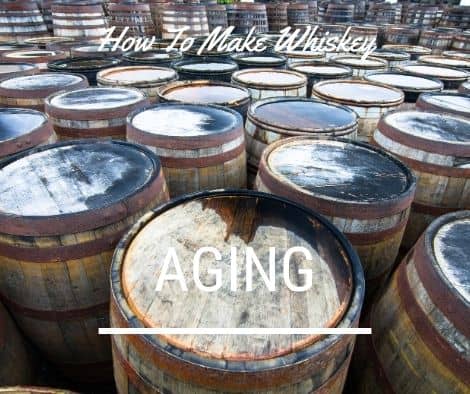
Even though it doesn’t take long to distill a barrel of whiskey, it does take time to achieve that peaty, golden whiskey profile that whiskey connoisseurs typically relish. The high wine when first distilled is clear, and tastes more like the grain it’s made from.
But things start to get interesting when the high wine goes into the wooden barrel. Most whiskies are aged in wood (oak) barrels, but corn whiskey can be aged or unaged. There are two major factors that dictate how each batch of whiskey will taste like decades into the future.
First is the type of barrel used in the aging process, and second is the environment the barrel is stored in. Water is added to the high wine to reduce the alcohol content down to 65 percent or more for Scotch whiskies, and 50 percent to 60 percent for American whiskies.
For Scotch whiskies to become less alcoholic, they are aged in warmer drier conditions, whereas American whiskies are aged in drier, warmer conditions to lose water, and boost their alcohol content.
It takes approximately between two to four years for whiskies to mature, but many premium whiskies are aged much longer, some more than 15 years. Each year of the aging process takes away two percent of the spirit due to natural evaporation.
The fact that there’s less whiskey in the cask to bottle explains why older whiskies are a treasure, and much more expensive. Whiskey is always bottled in glass bottles, because the golden liquid doesn’t react to glass to alter its flavor.
Is Gin Made from Whiskey?
Gin isn’t made from whiskey, but is made in the same way as whiskey, and distilled to a higher ABV. Further, gin and whiskey are made from the same grain mash, but are distinct from each other owing to the aging process.
Whiskey is aged for several years in oak barrels, but gin sits in barrels until it picks up flavors from the barrels i.e., between three to eight months until finish.
This is why some of the biggest brands of gin are produced at Scotch whiskey distilleries, as they can produce finished gin while they patiently wait for their whiskey to mature.
Whisky Making On A Small Scale
Now that you know how whiskey is made at a manufacturer level, it will easier for you to understand how to make whiskey at home. First, you have to choose your base, for which you’ve got several options to choose from including rye, wheat, barley, corn or a blend of different grains.
But if you’re just getting started with making whiskey, then it may be best to get started with corn – the easiest ingredient to get your hands on. Corn also is one the few home making whiskey ingredients that yields the most sugar, which is something that you ideally want.
And given that you probably need roughly 10 lbs of corn to make a reasonable volume of whiskey at home. it will be less expensive to buy to make approximately five gallons of final product.
Cooking Your Base
This is the part where you need to pay attention, because you will have to cook the corn base in water at considerably high temperatures to extract the sugars in the grain.
Manufacturers use industrial grade equipment to make the base aka mash, you can probably pull if off with one of the best home beer brewing kits, at least for the initial stages.
Fermentation Mash to Make Whiskey
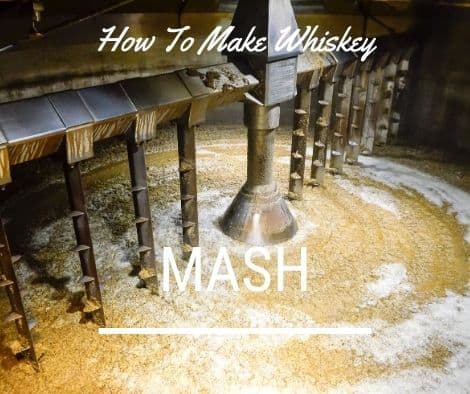
After you’ve cooked the grain and it’s transformed into mash, it’s time to get yeasting! Add some yeast to your cooked corn mash, and fire up the fermentation process in any type of sealed container or repurpose the home brewing beer kit to ease the process.
It is indeed better to ferment in a home brewing beer kit, as you can regulate the temperature, which helps because you don’t want the yeast to get too hot or else it will die. It may take several days for the fermentation process, so you just have to be patient.
Fermented home whiskey will start of as tasting fairly sweet to a fairly sour taste, which simply means that it’s working, and your sugar is being converted into alcohol.
Once the home made whiskey is fermented, you will need to strain the mash into a still, and since you don’t have an industrial grade appliance, a small scale home whiskey making still should do the trick.
Fire up the mash until it’s a piping hot 80 degrees Celsius, and let the mash convert into vapor. The vapor that rises from the still is basically converted back into liquid, which is voila your homemade whiskey.
Word of caution: You should probably not use the first 100 milliliters or so from the batch of homemade whiskey, as it might not taste great, and can be potentially dangerous to drink. To transform your raw whiskey into a finished product, you will have to let it age in a barrel.
You can leave the raw whiskey to age in the barrel for as long as you want, but the longer you leave in there, the more flavorful your homemade whiskey will be. This is why older whiskies cost more.
As easy as making whisky at home may seem, and even though you may have the right ingredients and equipment, we cannot stress this enough it is potentially dangerous, and illegal in all states to make spirits at home.
Fun Fact – How Do You Spell Whisky?
There is some confusion about how ‘whiskey’ is spelled. In the United States and Ireland, whiskey is spelled with an ‘e’. In Scotland, Canada, and Japan, it is spelled “whisky”.
Spelled whisky in Canada and Scotland, the word whiskey stems from Gaelic ‘uisge beatha’, or ‘usquebaugh’, meaning ‘water of life’, and is made from fermented grain and typically aged in wooden casks. It might help to remember that in countries with an ‘e’ in the name, the correct spelling is “whiskey”, with an ‘e’. In countries without an ‘e’ in the name, the correct spelling is “whisky”, without an ‘e’.


